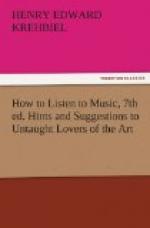That someone, of course, is the conductor, and considering the progress that music is continually making it is not at all to be wondered at that he has become a person of stupendous power in the culture of to-day. The one singularity is that he should be so rare. This rarity has had its natural consequence, and the conductor who can conduct, in contradistinction to the conductor who can only beat time, is now a “star.” At present we see him going from place to place in Europe giving concerts in which he figures as the principal attraction. The critics discuss his “readings” just as they do the performances of great pianists and singers. A hundred blowers of brass, scrapers of strings, and tootlers on windy wood, labor beneath him transmuting the composer’s mysterious symbols into living sound, and when it is all over we frequently find that it seems all to have been done for the greater glory of the conductor instead of the glory of art. That, however, is a digression which it is not necessary to pursue.
[Sidenote: Mistaken popular notions.]
[Sidenote: What the conductor does.]
[Sidenote: Rests and cues.]
Questions and remarks have frequently been addressed to me indicative of the fact that there is a widespread popular conviction that the mission of a conductor is chiefly ornamental at an orchestral concert. That is a sad misconception, and grows out of the old notion that a conductor is only a time-beater. Assuming that the men of the band have played sufficiently together, it is thought that eventually they might keep time without the help of the conductor. It is true that the greater part of the conductor’s work is done at rehearsal, at which he enforces upon his men his wishes concerning the speed of the music, expression, and the balance of tone between the different instruments. But all the injunctions given at rehearsal by word of mouth are reiterated by means of a system of signs and signals during the concert performance. Time and rhythm are indicated by the movements of the baton, the former by the speed of the beats, the latter by the direction, the tones upon which the principal stress is to fall being indicated by the down-beat of the baton. The amplitude of the movements also serves to indicate the conductor’s wishes concerning dynamic variations, while the left hand is ordinarily used in pantomimic gestures to control individual players or groups. Glances and a play of facial expression also assist in the guidance of the instrumental body. Every musician is expected to count the rests which occur in his part, but when they are of long duration (and sometimes they amount to a hundred measures or more) it is customary for the conductor to indicate the entrance of an instrument by a glance at the player. From this mere outline of the communications which pass between the conductor and his band it will be seen how indispensable he is if music is to have a consistent and vital interpretation.




